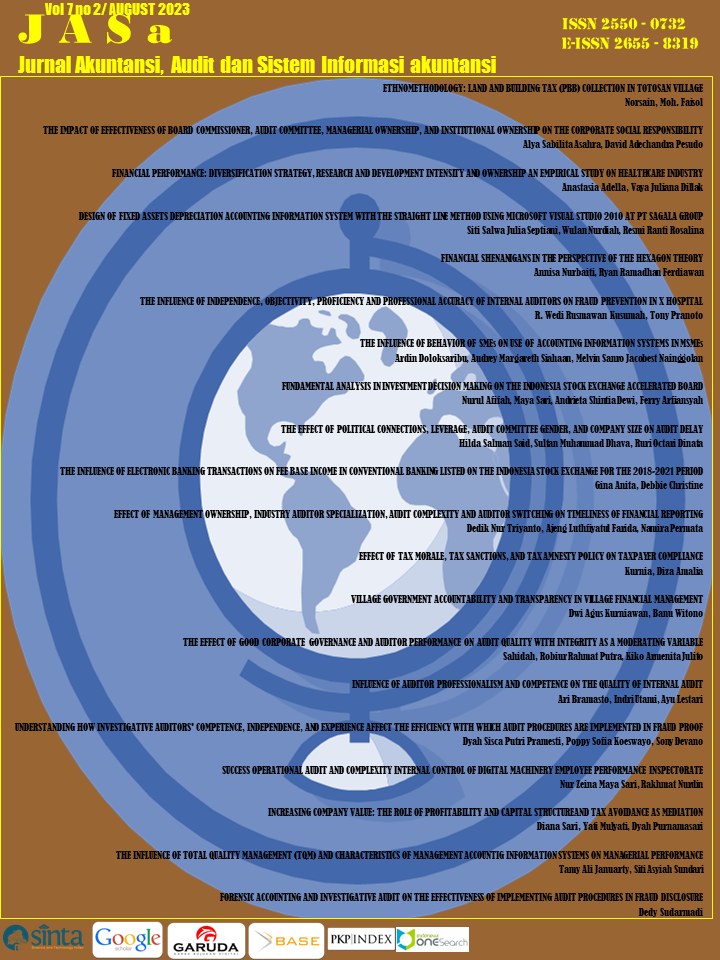Design of Fixed Assets Depreciation Accounting Information System with the Straight Line Method Using Microsoft Visual Studio 2010 at PT Sagala Group
Main Article Content
Abstract
For more than one accounting period, a business will likely make use of the physical assets that make up its fixed assets, such as those used in manufacturing, transportation, office space, and other structures. Investment in fixed assets must be carefully considered because to its high value, relatively extended usage, and status as the company's primary instrument for producing money. The value of fixed assets depreciates over time, and depreciation is the process through which that decline in value is accounted for. The straight-line depreciation approach is used by many businesses since it results in consistent expenses over time periods, regardless of changes in productivity or other factors. Therefore, it is essential that owned assets be properly managed so that businesses and individuals can continue to reap the rewards of their existence. However, this is not the case with PT Sagala Group still using Microsoft Excel to record its assets and calculate depreciation. Inaccuracies in fixed asset depreciation calculations, lags in recognizing physical data, and inadequate oversight of firm assets are only some of the issues discovered in the absence of supplementary software. In light of this issue, the authors reach the conclusion that a unified system for handling the various aspects of depreciating fixed assets should be created, with Microsoft Visual Studio 2010 and Microsoft Access 2010 serving as the respective database development and management tools. In the long run, having this system in place should make business operations easier.
Article Details

This work is licensed under a Creative Commons Attribution-NonCommercial-NoDerivatives 4.0 International License.
References
Arniati, & Windariyani, F. (2022). Penerapan Konsep Nilai Waktu Uang Pada Penyusutan Aktiva Tetap dan Pengaruhnya Terhadap Kewajiban Pajak pada PT Synergy Indonesia. Jurnal Akuntansi, Ekonomi, Dan Manajemen Bisnis, 3(1), 20–30.
Atmoko. (2013). Program Akuntansi Beserta Manajemen Asset Menggunakan VB dan SQL Server. PT Elex Media Komputindo.
Dzaky Prastianto, F., & Rostiani, Y. (2020). Komputerisasi Akuntansi Penyusutan Aktiva Tetap Metode Garis Lurus Berbasis Vb.Net Pada Pt Alam Makmur Karawang. Jurnal Interkom: Jurnal Publikasi Ilmiah Bidang Teknologi Informasi Dan Komunikasi, 15(1), 26–35. https://doi.org/10.35969/interkom.v15i1.85
Giri, E. . (2017). Akuntansi Keuangan Menengah 1 Perspektif PSAK dan IFRS. Unit Penerbit dan Percetakan Sekolah Tinggi Ilmu Manajemen YKPN
Isnaini, F., Aisyah, F., Widiarti, D., & Pasha, D. (2017). Perancangan Sistem Informasi Akuntansi Penyusutan Aktiva Tetap Menggunakan Metode Garis Lurus Pada Kopkar Bina Khatulistiwa. Jurnal Tekno Kompak, 11(2), 50. https://doi.org/10.33365/jtk.v11i2.172
Nadeak, B. (2016). Perancangan Aplikasi Pembelajaran Internet Dengan Menggunakan Metode Computer Based Instruction. JURIKOM (Jurnal Riset Komputer), 3(4), 54–57. http://ejurnal.stmik-budidarma.ac.id/index.php/jurikom/article/view/340
Romney, & Steinbart. (2018). Sistem Informasi Akuntansi: Accounting Information System. Pearson.
susanto azhar. (2013). Perancangan Sistem Pencatatan Pajak Reklame Pada Dinas Pendapatan Kota Pekanbaru Dengan Metode Visual Basic. Jurnal Ilmiah Ekonomi Dan Bisnis, 14(2), 160–180.
Sutarman. (2012). Pengantar Teknologi Informasi Edisi Pertama. Bumi Aksara.
Turner, L., Weickgenannt, A., & Copeland, M. K. (2017). Accounting Information System: Controls and Processes. John Wiley &Sons, Inc.
Vialny, M., & Doni, R. (2022). SISTEM INFORMASI PENYUSUTAN ASET DENGAN METODE GARIS LURUS DALAM PERHITUNGAN BEBAN PENYUSUTAN PADA KANTOR BEA DAN CUKAI TIPE MADYA PABEAN BELAWAN. Unes Journal of Information System, 7(2), 79–87.
Wahyudin, A., & Khafid, M. (2013). Akuntansi Dasar. Unnes Press.
Yesputra, R. (2017). Buku: Belajar Visual Basic. Net Dengan Visual. Studio 2010. Royal Asahan Press.

